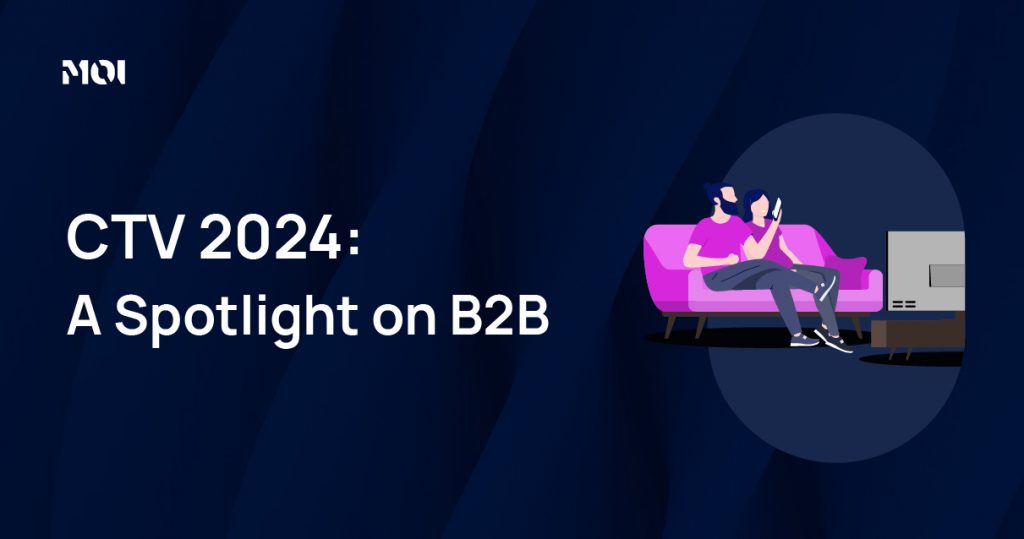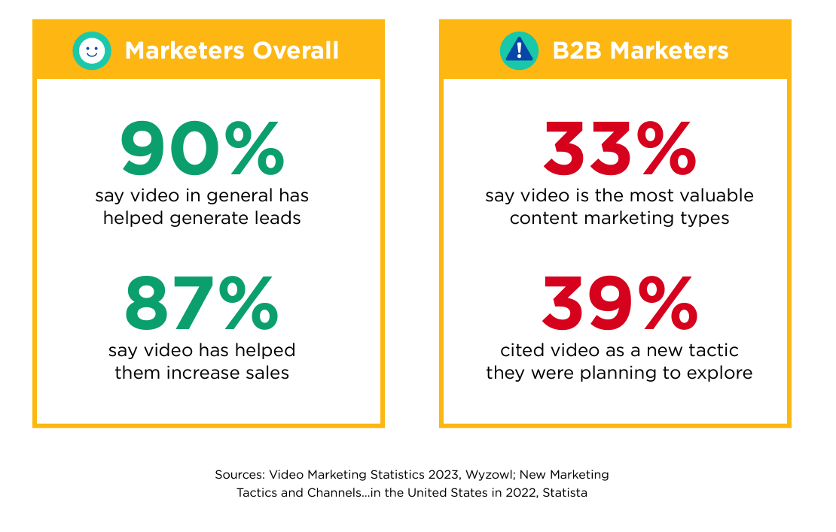
CTV. It’s a hot topic right now, and for good reason.
As with any shiny new object and buzzword, marketers can be quick to say “Yes!” and invest money in the channel with true due diligence. Because, after all, if your colleagues and other thought leaders are singing their praises, why shouldn’t you jump on the train too?
We’re not here to say NO, we’re not here to say YES, we are here to provide a state-of-the-union, if you will, on where CTV is today, where it’s headed tomorrow, and the questions you should consider asking before deciding it’s right for your organization’s GTM initiatives.
What is CTV
Connected TV (CTV) is a category of over-the-top (OTT) streaming devices that connect to or are embedded into a television to support video content streaming. This encompasses both Smart TVs and the devices connected to TVs, like sticks and gaming consoles, that give viewers access to a variety of streaming services like Netflix and Hulu.
Trends and Trajectories
- Growth: CTV remains one of the fastest growing channels with ad spend rising 19% in 2024 and a projected 13% in 2025.
- Linear vs. Digital: Linear TV will see a slight bump in ad spending this year thanks to the Summer Olympics and the US presidential election. But beyond 2024, linear investment will drop over 13% in 2025, and continue to decline, while CTV will follow the opposite trend line.
- Not just for Awareness: 49% of US advertisers are using CTV for lower funnel objectives and 64% for upper funnel goals. Why? Because video formats are not just for awareness anymore; storytelling has great impact throughout the entire customer journey. Secondly, the ability to measure impact / ROI with CTV is stronger than ever, especially vs. Linear.
- Measurement: Unlike most linear solutions, there is hope for CTV attribution using cross-device techniques. Cross-device attribution technology—which tracks conversions within a defined window of time from viewing the ad—is enabling marketers to prove ROI and guide decisions.
- Content isn’t Free: The future of CTV will be ad supported, with Amazon Prime video leading ad-supported OTT viewership, followed by Hulu and FAST (free ad supported streaming tv) is contributing to the rise in CTV inventory. Consumers shouldn’t be surprised by this as content isn’t free. From a marketer’s perspective, the cost of an ad spot may be on the pricier side, however targeting capabilities, measurement, and opportunities for engagement should make it worth the price.
- CTV outside of a TV: CTV doesn’t only occur on a traditional television, and the OOH market is capitalizing on that. DOOH (digital out of home) ad spend in the US will grow by 11.2% this year to reach $3.20 billion. DOOH is increasing its share of OOH as advertisers flock toward video and programmatic formats, including OOH TV. These small-screen formats (as opposed to larger digital billboards) are part of what may be referred to as OOH TV or CTV OOH. These are TV screens consumers watch when they aren’t at home, and they’re an important segment of DOOH.
CTV for B2B
- It’s not just for B2C: The lines between work and home are now blurred, with more professionals consuming content during flexible hours. They’re watching the news, industry-specific content, and more, making CTV a rich ground for B2B advertising.
- Targeting is getting smarter: The biggest argument for B2B companies is the fact that CTV targeting is heavily driven by IP addresses. This is also how account-based advertising works, by first associating a user with a company and then advertising to them if they’re a target account for a customer’s campaign. Instead of blanketing an entire population, you can directly target decision-makers in specific industries, job roles, or companies. Not only is this an argument for better conversion rates, but it also results in more cost-effective ad spend.
- Data is more robust: From CRM databases to website analytics, many B2B companies have a wealth of data with which to create detailed audience segments. When venturing into CTV advertising, this data must be used. Work with platforms that allow detailed targeting to ensure the right content reaches the right eyes. The more precise, the better the ROI.
- Effective retargeting: Retargeting viewers who engaged with your CTV ad on other platforms and using those insights from other channels can help refine your audience. For instance, if LinkedIn advertising data indicates a spike in interest from a particular industry, consider creating a targeted CTV ad campaign for decision-makers in that sector.
- Platform options: Platforms that allow for more precise B2B targeting on CTV include LinkedIn, some DSPs that integrate with B2B data providers, and those such as Madison Logic, Infuse Media, and MNTN. However, be cautious, as some may say they can do B2B targeting, but not specifically ABM. As such, these providers may still be too broad for your organization, and/or cannot target at scale outside of the US.
Lastly, we’d be remiss if we didn’t connect CTV with our battle cry at MOI, “Less about how you want to sell and more about how your consumers want to buy.” There’s a clear disconnect with consumer / decision maker preference and B2B marketer’s sentiment towards video in general.

It may be time to consider integrating and/or testing CTV into your marketing strategies.


